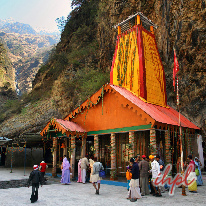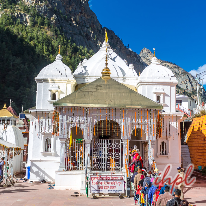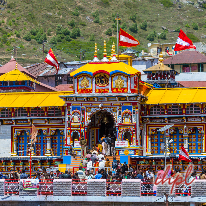






Char Dham Yatra pilgrims from around India, in 3 days, jumped to 1.5 lakhs since May 10, 2024 —a figure showing a 61% rise from 2023. Why so? It’s all because of the 4-holy shrines in the lapse of the Indian Himalayas in Uttarakhand, the Devbhoomi. These 4-holy Dhams (pilgrimage sites) together make for the Char Dham Yatra, not to be confused with the around India Char Dham Yatra (including Badrinath Dham, Rameshwaram Dham, Jagannath Puri Dham, and Dwarka Dham).
The Char Dham circuit within the northern state of Uttarakhand is also called Chota Char Dham. It has no relation to the Char Dham Yatra commenced by Adi Shankaracharya in the 8th century. The pilgrimage sites in the Char Dham Yatra within Uttarakhand are Yumnotri Dham, Gangotri Dham, Kedarnath Dham, and Badrinath Dham. They each have religious significance for the Hindu devotees who visit and offer prayers to the established God.
The Char Dham Yatra is famous among Hindu devotees because of its religious significance. The other inspiration to go on a Char Dham Yatra is an associated belief that one’s spirit gets Salvation (Moksha) on visiting these religious shrines. In Hindu Mythology, the Aatma (a person’s spirit) lives many mortal lives before attaining Salvation (becoming one with God). Devotees visit these 4 Dhams to free their spirits from the cycle of ‘birth’ and ‘death’ and find eternal peace.
These four sacred sites of Uttarakhand, till the 1950s, were out of reach for the devotees among the commoners. The route there was very strenuous and was often taken by Sadhus (Hindu monks) or people capable of taking entourages. After the Indo-China War in 1962, the government started building motorable routes to Himalayan borders. This initiative made these Dhams accessible to the commoners. Every year, the Uttarakhand government builds more facilities to make the Char Dham Yatra comfortable and safe for all the devotees. The services that the government is continuously improving are:
Uttarakhand is a beautiful state with its share of mesmerizing Himalayas. The 4-pilgrimage sites (Dhams) of the Char Dham Yatra are all in the Himalayas therefore are only open from summer (April or May) till post-monsoon (October or November) season. The routes to these sites close during the winter, wherein the idols are kept and worshiped in winter stays dedicated to these idols. These idols are there till the Kiwads (doors) to the Char Dhams open again in summer.
Note: The Char Dham Yatra completes clockwise, from the west to the east. The most popular trail for Char Dham is:
Haridwar → Rishikesh → Devprayag → Tehri → Dharasu → Yamunotri → Uttarkashi → Gangotri → Gaurikund → Kedarnath → Joshimath → Badrinath.
To Visit: Kharsali, Divya Shila, Saptrishi Kund, Barkot, Surya Kund, Hanuman Chatti, Yamunotri Temple, and Janki Chatti.
Peaks In Vicinity: Kalind Parbat, Bandarpoonch, Swargarohini, and Kalanag Peak.
Yamunotri Dham is the first of the Char Dhams in the Char Dham Yatra. It is the abode of Goddess Yamuna. She is the daughter of Surya Dev and the sister of Yama and Shani Dev. Bathing in Yamuna’s waters is believed to be sin-rinsing. Devotees also believe that it helps you escape untimely death. Yamunotri Dham is also the source of River Yamuna, the second pious river in Hindu Mythology.
To Visit: Pandava Gufa, Gangotri National Park, Gangotri Temple, Harsil, Gauri Kund, Surya Kund, Dharali, Bhagirathi Shila, Kedartal, Tapovan, Jalmagna Shivling, Vishwanath Temple, and Gaumukh.
Peaks In Vicinity: Chaukhamba III, Chaukhamba II, Chaukhamba I, Kedarnath Main, and Satopanth.
Gangotri Dham, as the name implies, is home to Goddess Ganga. Maa Ganga (River Ganges), the purest river in Hindu mythology, originates from Gangotri. Here, the river is known by the name Bhagirathi, commemorating a king who, after ages of penance, pleased Ganga and freed his ancestors.
Gangotri Dham is visited second in the Char Dham Yatra, following the ancient tradition of going West to East. Devotees visit here to attain Salvation (moksha). If not equivalent to King Bhagirath, then something near to it.
To Visit: Sonprayag, Shankaracharya Samadhi, Bhairavnath Temple, Chorabari Lake, Gaurikund, Triyuginarayan, Kedarnath Temple, Agastyamuni, and Ukhimath.
Peaks In Vicinity: Kedarnath Main, Kedarnath Dome, Thalaysagar, Shivling, and Meru.
Kedarnath Dham is one of the most revered temples of Lord Shiva, which echoes with the sounds of ‘Har-Har Mahadev’ and ‘Om Namah Shivay.’ This shrine is said to have been built by Pandavas (the five brothers from Mahabharata). After taking the form of a bull, Lord Shiva went inside Prithvi (Goddess Earth). The Pandavas offered prayers here and the remaining 4-Kedars as a penance for their sins in the battle of Mahabharata.
Kedarnath Dham becomes the third stop for pilgrims on the Char Dham Yatra. Here you see the Mandakini River flow out of its source nearby. Like Pandavas were free of guilt and sins, devotees visit Kedarnath Temple with the same fate in mind. Their faith takes them on this trek. Their faces have no visible stress, only hope.
To Visit: Bheem Pul, Vyas Gufa, Tapt Kund, Narada Kund, Shri Badrinath Ji Temple, Vasudhara Falls, Saraswati River, Brahma Kapal, and Yog Dhyan Badri.
Peaks In Vicinity: Neelkanth Peak, Nar and Narayan Mountain Ranges, Mana, Kamet, Mandir Parbat, and Deoban Peak.
Badrinath Dham is the place of worship of Lord Vishnu, the protector of life in Hinduism. This temple is the 4th Dham that devotees visit in the Chota Char Dham Yatra, but also one of the Char Dhams suggested by Adi Shankaracharya. Lord Vishnu came to meditate here, and Lakshmi Ji (Goddess of Wealth) followed suit to give him shade as a Badri tree. Another story that explains the origins of this pious temple is that it’s the ashram of Nar and Narayan, the avatars of Lord Vishnu.
Millions of devotees visit this shrine every year. Badrinath blesses them with the view of its black stone idol, one of the Swayam Vyakta Kshetras. Devotees compulsorily take a dip in the Tapt Kund, which has many medicinal benefits apart from the religious ones. The Badri-Kedar festival and the Murti Ka Mela are occasions when Badrinath is flooded with crowds.
Char Dham Yatra is not open throughout the year, it usually begins with the opening date of the temples, decided by the priests. They decide on these opening and closing dates based on the Hindu calendar (Panchang).
For Yamunotri, the opening date announced by the priest coincides with Akshay Tritiya. Following a similar tradition, the closing date coincides with Bhai Dooj.
For Gangotri, the opening date is the same as Yamunotri: Akshay Tritiya. However, Gangotri closes on the date of Govardhan Puja for pilgrims.
For Kedarnath, both opening and closing dates coincide with Yamunotri. It opens on Akshya Tritiya and closes on Bhai Dooj. The announcement is made by Ukhimath Mandir’s (Temple) priest on Mahashivratri.
For Badrinath, there are no sealed dates in the Panchang. The announcement for opening and closing dates are closely monitored. These announcements are made on the same occasions, year after year. The opening date is announced on Basant Panchami while the closing date is announced on Vijayadashami.
| TEMPLES | OPENING DATE | CLOSING DATE |
|---|---|---|
| Yamunotri Temple | 10th May 2024 | 03rd November |
| Gangotri Temple | 10th May 2024 | 02rd November |
| Kedarnath Temple | 10th May 2024 | 03rd November |
| Badrinath Temple | 12th May 2024 | 17rd November |
| Hemkund Sahib | 25th May 2024 | 10th October ( Closed ) |
Char Dham Yatra in Uttarakhand was once an arduous task where devotees second-guessed themselves. With time, the motorable roads made them (Yamunotri, Gangotri, Kedarnath, and Badrinath) more accessible and thus more doable. The helicopter services have only made things easier for pilgrims who lost hope of ever experiencing the abodes of their revered deities.
Helicopter services are now available for the Char Dham Yatra. They include your return to where you started and a comfortable stay mid-Yatra. Devotees can also opt for Do Dham Yatra to Kedarnath and Badrinath. Finally, helicopter services are also available for each Dham separately.
Helicopter Services have made it possible for every devotee, regardless of age and ability, to visit the Char Dhams. Along with time, they also save strenuous work that goes into trekking to the Dhams, especially the treks to Kedarnath and Yamunotri Dhams.
The Char Dham Yatra by heli services/air usually follows the route below:
Reach Dehradun ➼ Report at Sahastradhara Helipad ➼ Fly to Kharsali Helipad ↔ 5 km trek to Yamunotri Dham ➼ Fly to Harsil Helipad ↔ 25 km drive to Gangotri Dham ➼ Fly to Kedarnath Helipad ➼ .5 km walk to Kedarnath Dham ➼ Stay at Guptkashi ➼ Fly to Badrinath Helipad ↔ 1 km drive/walk to Badrinath Dham ➼ Fly to Sahastradhara Helipad ➼ Leave Dehradun.
You can choose the ‘by air’ package with us (Trekking Compass) or book it directly from IRCTC’s website. It is the only website providing online booking of heli services for Char Dham Yatra.
Note: Before booking the helicopter services, you should be mandatorily registered for the Char Dham Yatra by the Uttarakhand Government.
The Char Dham Yatra is a Teerth Yatra (Pilgrimage) made to grind you physically. The strenuous nature of the journey makes it all the more rewarding and awakening. Hindu devotees around India aim to reach these shrines at some point in life. Here’s how to access these sites:
By Flight:
Nearest Airport: Jolly Grant Airport, Dehradun
| Dham | Distance Covered by Flight | Distance Remaining (by road) | Distance Remaining (by helicopter) |
|---|---|---|---|
| Yamunotri | Delhi to Dehradun (202 km) | 175 km + 6 km trek | 87 km + 5 km trek |
| Gangotri | Kolkata to Dehradun (1,336 km) | 237 km | 104 km + 25 km (drive) |
| Kedarnath | Pune to Dehradun (1,377 km) | 243 km + 22 km | 109 km + .5 km (walk) |
| Badrinath | Mumbai to Dehradun (1,345 km) | 323 km | 148 km + 1 km (drive/walk) |
By Train:
For Yamunotri & Gangotri: The nearest railway station is Dehradun Railway Station.
For Kedarnath & Badrinath: The nearest railway stations are Rishikesh and Haridwar.
By Road:
Yamunotri:
Gangotri:
Kedarnath:
Badrinath:



